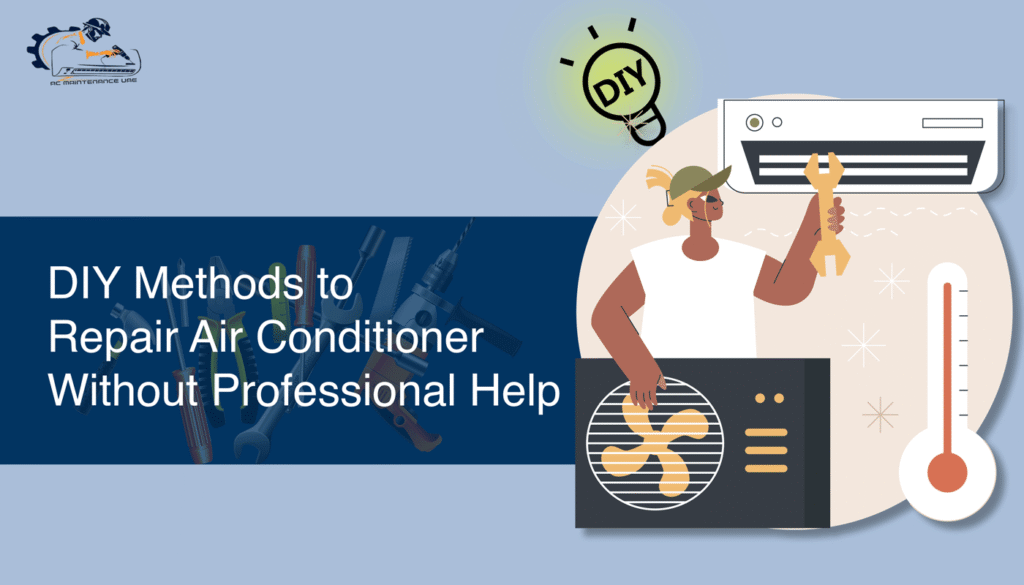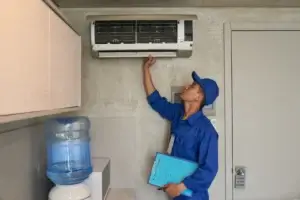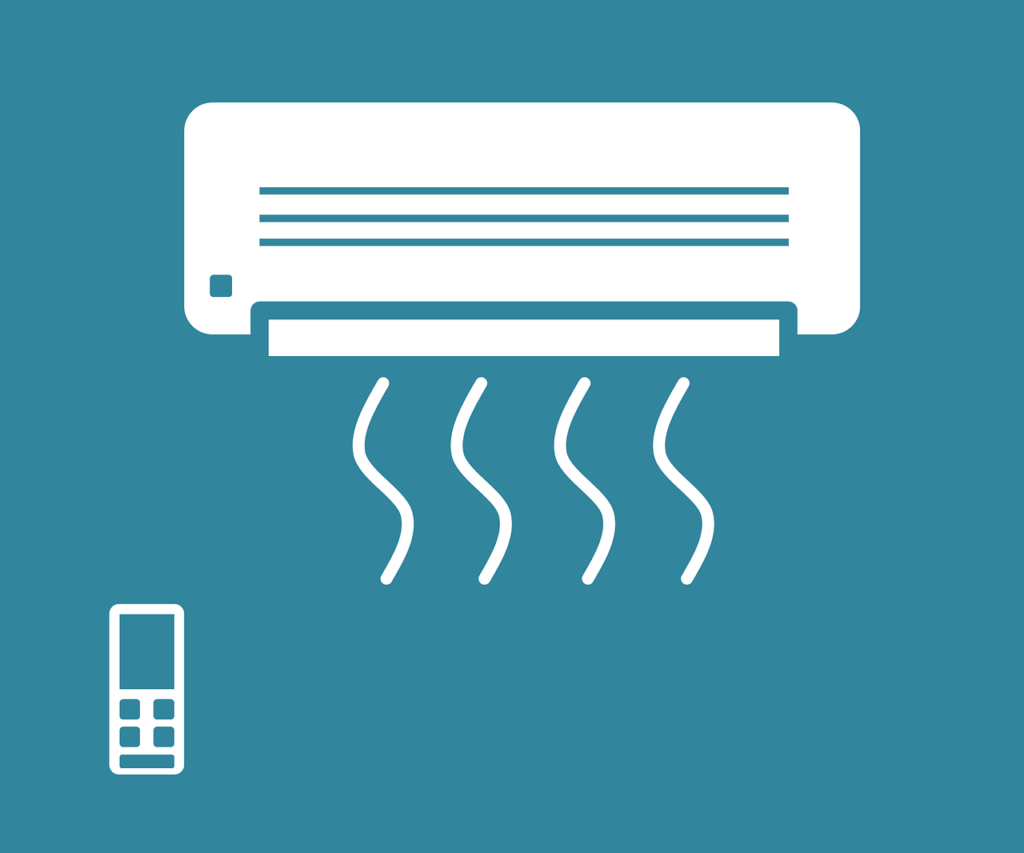Is your air conditioner failing to cooperate at the time you need it the most? You are not alone; numerous homeowners across the country experience frustrating AC problems, which may sound complicated, but can be dealt with using basic knowledge. This manual will demonstrate how you can easily fix air conditioner issues on your own with the proven tips of how to repair air conditioning, save money, and have the confidence to face frequent cooling problems before they blow out of control.
Essential Tools and Safety Tips to Repair Air Conditioner

To safely work on your cooling system, you require proper equipment and knowledge before getting into repairs. Here, we discuss necessary items, essential safety measures, and fundamental AC parts that you ought to be familiar with before engaging in any form of work related to AC unit repair.
Must-Have Tools for DIY AC Repair
Safely and effectively, collect the appropriate equipment before trying any AC unit repair. The right tools not only make the process of repairing your system less difficult, but they also assist in minimizing the possibility of damaging your system and keeping you safe during the process.
The necessary air conditioner repair tools are:
- Electrical testing voltage meter.
- Flathead and Phillips head screwdrivers.
- A wrench that can be adjusted to tighten nuts and bolts.
- Fin Tilter coils of the condenser.
- Wet/dry vacuum to clean up drain lines and remove debris.
- Flashlight to examine the dark places.
- Personal protective equipment in the form of protective goggles and gloves.
- Coil cleaner fluid to keep up the condenser efficiency.
Important Safety Guidelines Before Starting Repairs
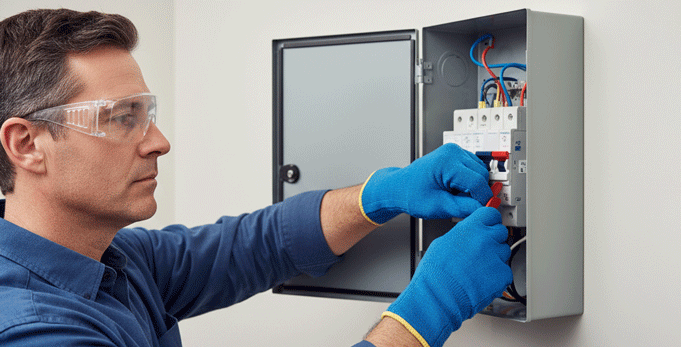
Always remember that safety is the key to working on the air conditioner repair. Using correct safety measures will save you from electric shock, physical injury, and damage to the system, which may involve expensive professional repairs.
The important safety precautions involve:
- When starting work, turn off the power at both the thermostat and the circuit breaker.
- Do not work in the wet or on unsteady footings.
- Working alone on the outside units, particularly on ladders, is not to be considered.
- Always do not touch electrical parts without appropriate testing using a multimeter.
- Be aware of your boundaries regarding refrigerant-related activities that have to be carried out by a professional.
It is important to remember that there are certain tasks related to refrigerant that are characterized as being related to the AC system repair and should not be performed by a person, as they should be handled by a professional.
Understanding Your Air Conditioner’s Main Components
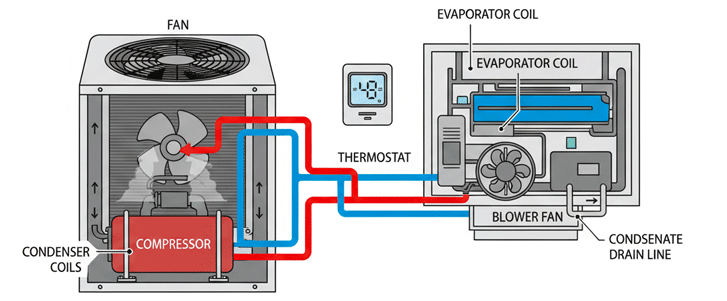
Being aware of the way your cooling system functions will assist you in diagnosing the problems correctly. The knowledge of what each component does will enable you to troubleshoot, identify problems fast, and decide whether or not you can repair it on your own.
Key AC components include:
- Outdoor unit: has the compressor, condenser coil, and fan that discharge heat to the outside.
- Indoor evaporator coil: chills the air before circulation.
- Blower system: a system that moves cooled air in your house.
- Air filters: capture dust and debris to sustain the air quality.
- Thermostat: manages the whole system according to the temperature settings.
- Drain lines: remove condensation that is generated during cooling.
When one becomes familiar with these elements, the identification of AC problems and solutions becomes easier.
DIY Methods to Repair Air Conditioner: Step-by-Step Guide
This detailed manual will take you through the most typical AC repairs that a homeowner can do on their own. Starting with thermostat issues to drainage issues, you will discover how to efficiently correct your cooling system without spending a lot to call a service..
Fixing AC Thermostat Issues
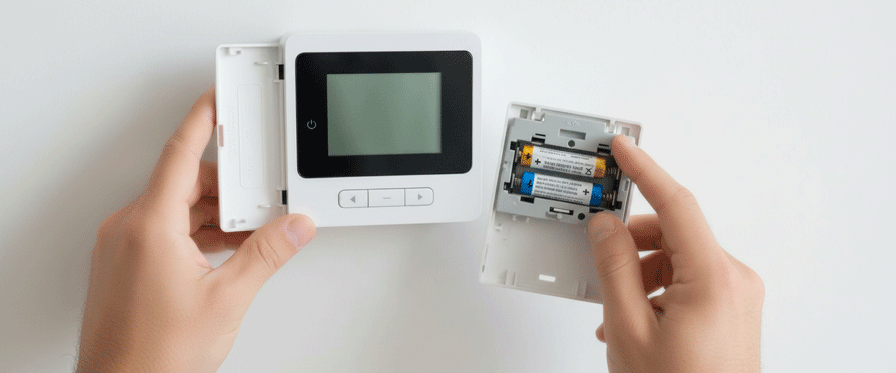
- Change battery and calibration: Remove thermostat cover, remove old batteries, and insert new ones of a similar type. After replacement, the thermostat will need to be recalibrated by comparing the thermostat reading with the precise thermometer near the thermostat..
When the difference is too large, then turn the calibration screw or call up the built-in calibration menu of your thermostat. This is a quick and easy ac thermostat repair that is frequently done when your system is not responding to any temperature adjustments.
- Wiring inspection and simple repair: Disable power, then inspect the wiring of the thermostats. Take off the cover and check to see whether there are loose, corroded, or disconnected wires. All wires are connected to a labeled terminal. Common ones are: R (power), G (fan), Y (cooling), and W (heating). Loosely fitting connections should be carefully tightened, and corroded terminals cleaned with a small wire brush.
Improving Weak Airflow
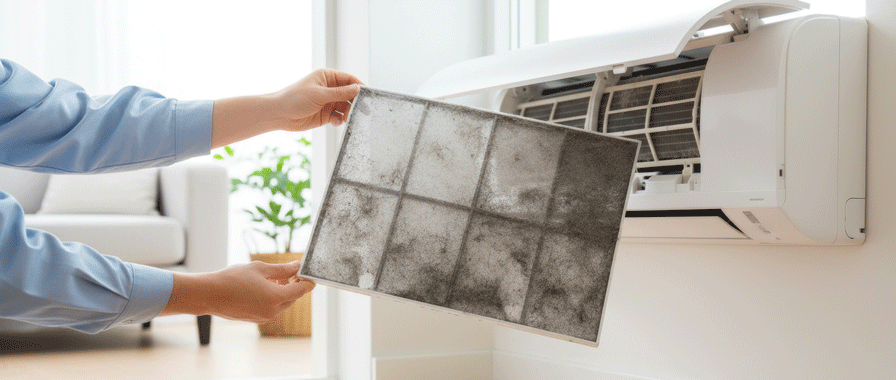
- Cleaning or replacing filters: Find your filter, typically behind a vent returning air or inside the air handler. Get it out and put it to light, and, when you find you cannot see through it easily, get another. Disposable filters are to be changed in 1-3 months. This basic care significantly enhances your “AC unit repair work.
- Unblocking blocked vents and ducts: Make sure that furniture or curtains are not covering the supply or return vent. Take off vent covers and use a flashlight to inspect visible obstruction. A vacuum that is fitted with a hose can remove debris that can be reached in ductwork.
- Cleaning condenser coils manually: Ideas that are simple to implement. Turn the power off and then remove the protective grille of your outside unit. Using a soft brush, remove any loose debris on the fins. Clean with spray and water, then use a garden hose on the inside and the outside.
Resolving Drainage Problems
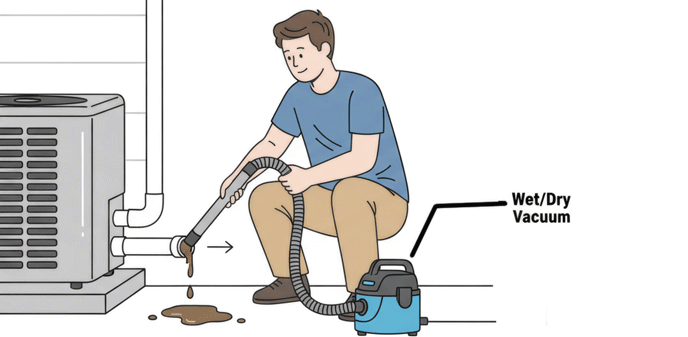
- Cleaning clogged drain lines: Find the drain line, which is typically a PVC pipe close to your indoor unit. Remove it and empty it with a wet/dry vacuum on both ends. To deal with obdurate clogs, add a cup of distilled vinegar to the line and allow it to rest 30 minutes, then force a flush.
- Keeping the condensate pan: Have a look at the condensate pan under your evaporator coil, and take it out and clean it. Strain the standing water and rinse the pan with soap and water. Check out cracks or rust that will cause leakages.
- Water leaks in the system: Check that your condensate pump is operational by filling the pump reservoir with water and making sure that it turns on. Check and seal drain lines and connections to make sure they are not leaking.
Addressing Strange Noises
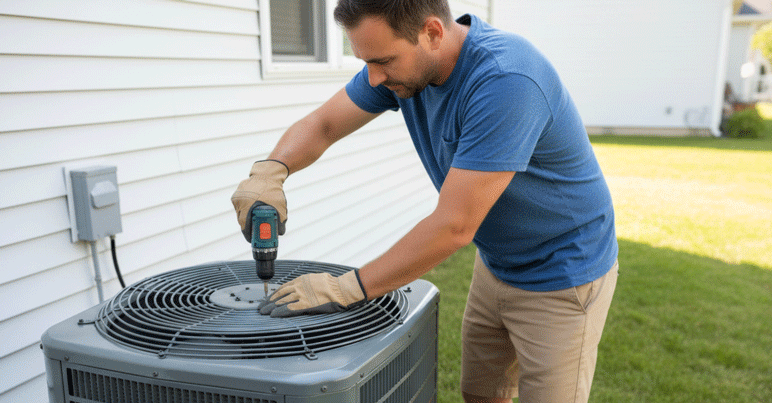
- Securing loose parts: Turn off, check the fan blade, top grill, and opening covers of your outdoor unit. Screws or bolts that are loose must be tightened.
- Oiling moving parts: Refer to your owner’s manual, which points to the need for lubrication to get ports labeled with oil. Apply the type and quantity of lubricant suggested.
- Removing debris in the outdoor unit: Disconnect the power and remove the top grille. Test for leaves, grass cuttings, or twigs in and clean up all rubbish either by hand or using a shop vac.
When the AC System Won’t Turn On
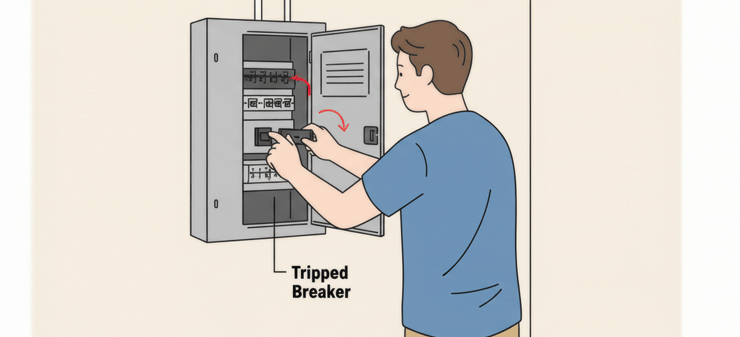
- Check of circuit breakers: Begin troubleshooting where your electrical panel is located. Find a tripped breaker; it can be midway between ON and OFF. Turn it off completely, wait 30 seconds, and turn it ON. In case the breaker is repeatedly tripping, then you have an electrical issue that should be addressed by a professional.
- Re-setting your air conditioner: There is a reset button on most systems on the outside unit or on the inside air handler. Once the thermostat has been turned off, find this button, which is normally a red and recessed button. Press and hold for 3-5 seconds. At least allow 30 minutes before switching your system on again.
- Simple electric troubleshooting: Test your disconnect box in the yard with a multimeter to determine whether it has power. Test voltage at the disconnect- you are supposed to read about 240 volts in residential systems. When power is at the disconnect but not at the unit, make sure the fuses in the disconnect box are good and change those that are blown.
Preventive Maintenance Tips for Long-Term AC System Repair Savings
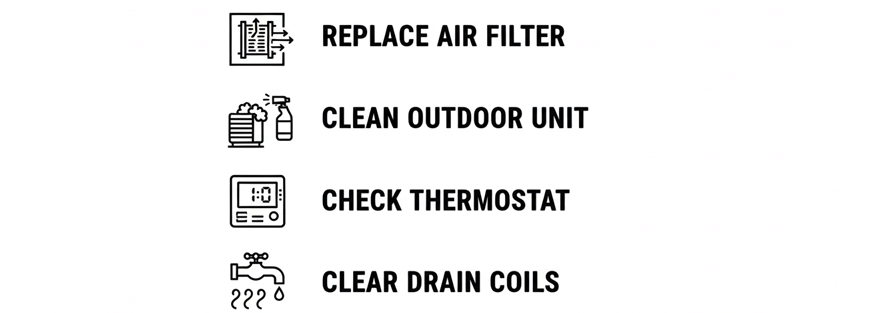
Routine maintenance will save you the expensive service failures and will serve your air conditioner with a long life. These monthly and seasonal care plans ensure that your system is running smoothly and that you are able to spot minor issues before they turn into costly maintenance issues.
Monthly DIY Air Conditioner Maintenance Checklist
The majority of emergencies can be avoided through regular care monthly. Every month, replace your air filter in heavy-use seasons. Inspected your external unit to make sure that the space is well clear and that there is no debris. Watch and listen when your system is running and test your thermostat by changing temperature settings. These are easy AC repair tips that help to maintain your system in an efficient state.
Seasonal Care to Keep Your AC Running Efficiently
Preparation of the spring is essential before the start of the cooling season. Clean coils inside and outside, and also check all electrical connections for corrosion. Bend your condenser coils with a fin comb to straighten any bends. Test your system during a not-so-hot day to see the problems before the extreme weather arrives. These proactive AC maintenance measures maximize efficiency and minimize breakdowns.
Know Your Limits: When to Skip DIY AC Repairs
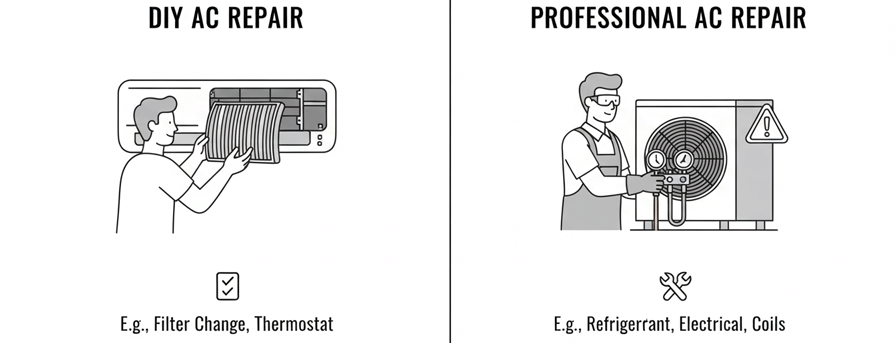
Knowing when to address professionals can help keep you safe, as well as avoid additional harm. Some of these repairs would deal with dangerous materials or complicated systems that need professional attention. Certain air conditioner repairs are too complex and require specialized knowledge and tools that are not readily available in the DIY realm. Turn these jobs into a company that repairs the air conditioner:
- Leaks and recharging of refrigerants: Entail the use of EPA-regulated substances, which must be certified.
- Compressor or motor failures: It is an advanced and expensive element that needs a specialized diagnosis.
- Tricky electrical issues: More than just connections, high voltage, and safety hazards.
- Repair of sealed systems: There is a warranty issue; warranties are invalidated by opening sealed parts, and special equipment is required.
In this instance, contact specialists like us, the AC Maintenance UAE, to avoid injuries, further damage, or warranty breach.
Frequently Asked Questions
Q1. What do you save when you do DIY AC repair versus doing professional repairs?
It would save you 60-80 percent of a standard maintenance fee, and compare the cost of repair to AED 40-180 in supplies versus AED 275-735 in calls to a professional service company.
Q2. What are the top 5 AC issues that I can repair myself?
Dirty filters, plugged-up drain lines, tripped breakers, and dead batteries in thermostats are the simplest to correct.
Q3. Will my warranty for the air conditioner get voided by DIY repair?
Basic repairs like changing filters will not invalidate warranties, but repair of closed system parts or refrigerating systems will.
Q4. What are some of the basic tools required to repair a home AC?
It will require screwdrivers, an adjustable wrench, a multimeter, a fin comb, safety equipment, a flashlight, and a wet/dry vacuum.
Conclusion
Knowing how to do it on your own by learning to repair air conditioner problems will enable you to manage the frequent problems swiftly and save money. These AC repair tips will assist in keeping your home comfortable at a low cost, whereas preventive maintenance helps to avoid costly failures.
AC Maintenance UAE Team
Welcome to AC Maintenance UAE, your reliable partner for complete air conditioning repair and maintenance services in Dubai, Sharjah, and Abu Dhabi. We are strongly dedicated to excellence and deliver efficient and reliable services to keep your cooling systems performing at their best.
- AC Maintenance UAE Teamhttps://acmaintenanceuae.com/author/ac_mainten_admin/
- AC Maintenance UAE Teamhttps://acmaintenanceuae.com/author/ac_mainten_admin/
- AC Maintenance UAE Teamhttps://acmaintenanceuae.com/author/ac_mainten_admin/
- AC Maintenance UAE Teamhttps://acmaintenanceuae.com/author/ac_mainten_admin/

